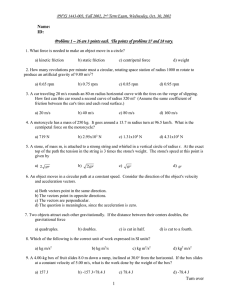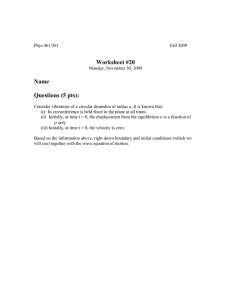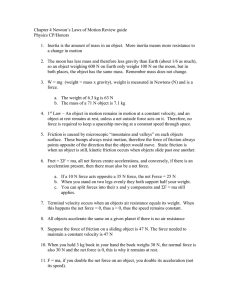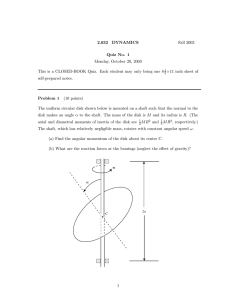PHYS 1443-003, Fall 2002, 2nd Term Exam, Wednesday, Oct. 30
advertisement
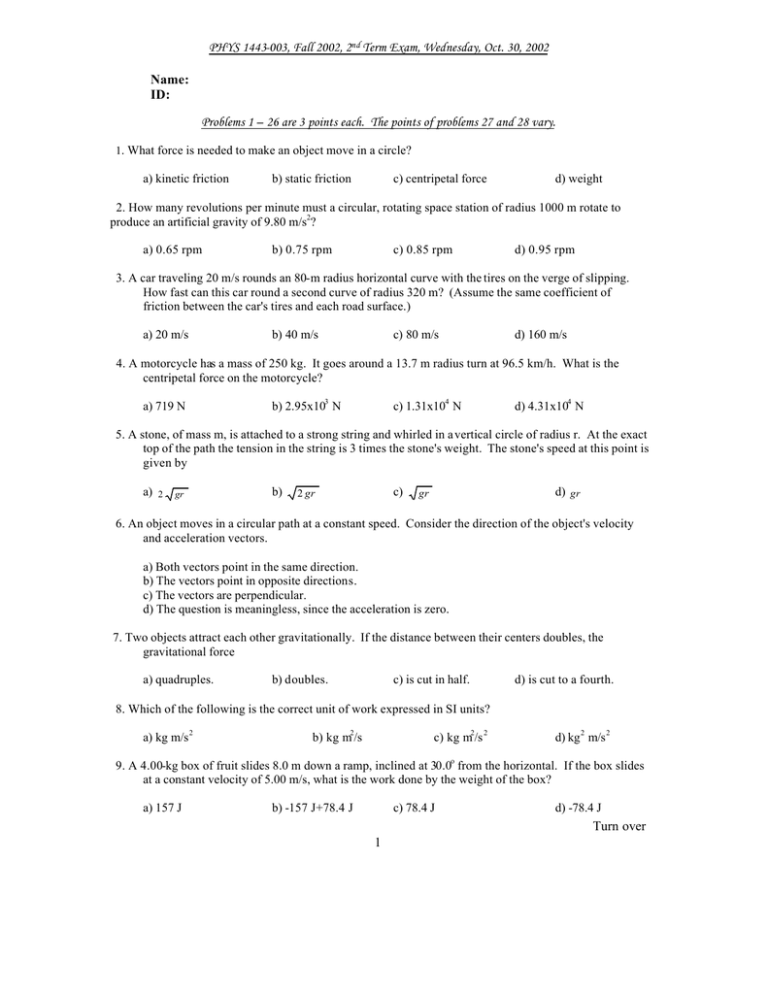
PHYS 1443-003, Fall 2002, 2nd Term Exam, Wednesday, Oct. 30, 2002 Name: ID: Problems 1 – 26 are 3 points each. The points of problems 27 and 28 vary. 1. What force is needed to make an object move in a circle? a) kinetic friction b) static friction c) centripetal force d) weight 2. How many revolutions per minute must a circular, rotating space station of radius 1000 m rotate to produce an artificial gravity of 9.80 m/s2? a) 0.65 rpm b) 0.75 rpm c) 0.85 rpm d) 0.95 rpm 3. A car traveling 20 m/s rounds an 80-m radius horizontal curve with the tires on the verge of slipping. How fast can this car round a second curve of radius 320 m? (Assume the same coefficient of friction between the car's tires and each road surface.) a) 20 m/s b) 40 m/s c) 80 m/s d) 160 m/s 4. A motorcycle has a mass of 250 kg. It goes around a 13.7 m radius turn at 96.5 km/h. What is the centripetal force on the motorcycle? a) 719 N b) 2.95x103 N c) 1.31x104 N d) 4.31x104 N 5. A stone, of mass m, is attached to a strong string and whirled in a vertical circle of radius r. At the exact top of the path the tension in the string is 3 times the stone's weight. The stone's speed at this point is given by a) 2 gr b) c) 2 gr d) gr gr 6. An object moves in a circular path at a constant speed. Consider the direction of the object's velocity and acceleration vectors. a) Both vectors point in the same direction. b) The vectors point in opposite directions. c) The vectors are perpendicular. d) The question is meaningless, since the acceleration is zero. 7. Two objects attract each other gravitationally. If the distance between their centers doubles, the gravitational force a) quadruples. b) doubles. c) is cut in half. d) is cut to a fourth. 8. Which of the following is the correct unit of work expressed in SI units? a) kg m/s 2 b) kg m2/s c) kg m2/s 2 d) kg 2 m/s 2 9. A 4.00-kg box of fruit slides 8.0 m down a ramp, inclined at 30.0o from the horizontal. If the box slides at a constant velocity of 5.00 m/s, what is the work done by the weight of the box? a) 157 J b) -157 J+78.4 J c) 78.4 J d) -78.4 J Turn over 1 PHYS 1443-003, Fall 2002, 2nd Term Exam, Wednesday, Oct. 30, 2002 10. If you push twice as hard against a stationary brick wall, the amount of work you do a) doubles c) remains constant but non-zero b) is cut in half d) remains constant at zero 11. A driver, traveling at 22 m/s, slows down her 2000 kg car to stop for a red light. What is the work done by the friction force against the wheels? a) -2.2X104 J b) -4.4X104 J c) -4.84X105 J d) -9.68X105 J 12. The quantity 1/2 mv 2 is a) the kinetic energy of the object. c) the work done on the object by the force. b) the potential energy of the object. d) the power supplied to the object by the force. 13. An 800-N box is pushed up an inclined plane. The plane is 4.0 m long and rises 2.0 m. It requires 3200 J of work to get the box to the top of the plane. What was the magnitude of the average friction force on the box? a) 0 N c) 400 N b) Non-zero, but less than 400 N d) Greater than 400 N 14. A 50-kg pitching machine (excluding the baseball) is placed on a frozen pond. The machine fires a 0.40-kg baseball with a speed of 35 m/s in the horizontal friction. What is the recoil speed of the pitching machine? (Assume negligible friction.) a) 0.14 m/s b) 0.28 m/s c) 0.70 m/s d) 4.4x10 3 m/s 15. A 10.0-g bullet moving at 300 m/s is fired into a 1.00-kg block. The bullet emerges (the bullet does not embedded in the block) with half of its original speed. What is the velocity of the block right after the collision? a) 1.50 m/s b) 2.97 m/s c) 3.00 m/s d) 273 m/s 16. A constant 6.0-N net force acts for 4.0 s on a 12 kg object. What is the object's change of velocity? a) 2.0 m/s b) 12 m/s c) 18 m/s d) 288 m/s 18. A 3.0-kg object moves to the right with a speed of 4.0 m/s. It collides in a perfectly elastic collision with a 6.0-kg object moving to the left at 2.0 m/s. What is the total kinetic energy after the collision? a) 72 J b) 36 J c) 24 J d) 0 J 19. Three masses are positioned as follows: 2.0 kg at (0, 0), 2.0 kg at (2.0, 0), and 4.0 kg at (2.0, 1.0). Determine the coordinates of the center of mass. a) (0.50, 1.5) b) (1.5, 0.50) c) (2.5, 1.5) d) (2.5, 0.50) Turn over 2 PHYS 1443-003, Fall 2002, 2nd Term Exam, Wednesday, Oct. 30, 2002 20. Which of the following is a false statement? a) For a uniform symmetric object, the center of mass is at the center of symmetry. b) For an object on the surface of the earth, the center of gravity and the center of mass are the same point. c) The center of mass of an object must lie within the object. d) The center of gravity of an object may be thought of as the "balance point." 21. A plane, flying horizontally, releases a bomb, which explodes before hitting the ground. Neglecting air resistance, the center of mass of the bomb fragments, just after the explosion a) is zero. c) moves vertically. b) moves horizontally. d) moves along a parabolic path. 22. A wheel of radius 1.0 m is rotating with a constant angular speed of 2.0 rad/s. What is the linear speed of a point on the wheel's rim? a) 0.50 m/s b) 1.0 m/s c) 2.0 m/s d) 4.0 m/s 23. Consider a rigid body that is rotating. Which of the following is an accurate statement? a) Its center of rotation is its center of gravity. b) All points on the body are moving with the same angular velocity. c) All points on the body are moving with the same linear velocity. d) Its center of rotation is at rest, i.e., not moving. 24. Consider two uniform solid spheres where both have the same diameter, but one has twice the mass of the other. The ratio of the larger moment of inertia to that of the smaller moment of inertia is a) 2 b) 8 c) 10 d) 4 25. What is the quantity used to measure an object's resistance to changes in rotation? a) mass b) moment of inertia c) torque d) angular velocity 26. A triatomic molecule is modeled as follows: mass m is at the origin, mass 2m is at x = a, and, mass 3m is at x = 2a. What is the moment of inertia about the origin? a) 2 m a2 b) 3 m a2 c) 12 m a2 d) 14 ma 2 Turn over 3 PHYS 1443-003, Fall 2002, 2nd Term Exam, Wednesday, Oct. 30, 2002 27. A billiard ball with a speed of v1 collides head-on elastically with an identical ball moving with a speed v 2 in the opposite direction. a) What are the quantities conserved in this collision? (4 points) b) Determine the speeds of both balls after the collision. (7 points) Turn over 4 PHYS 1443-003, Fall 2002, 2nd Term Exam, Wednesday, Oct. 30, 2002 28. A very thin aluminum rod of length L has a density that varies as a function of the position in the rod, λ = αx , where α is a constant and x is the position from the origin where the rod’s axis of rotation is. a) What is the total mass of the rod? (3 points) b) What is the moment of inertia of this rod when it rotates about the axis located at one end (x=0)? (5 points) c) What is the rotational kinetic energy of the rod when its angular speed is ω in the rotation above? (3 points) Turn over 5 PHYS 1443-003, Fall 2002, 2nd Term Exam, Wednesday, Oct. 30, 2002 Useful Formulae and information Velocity: v f = vi + at 1 2 at 2 Angular velocity: ϖ f = ϖ i + αt Position: r f = ri + vi t + Angular Displacement: θ f = θ i + ϖ i t + ∑m r = ∑m i Center of Mass: r CM 1 2 αt 2 i i i i Moment of Inertia: I = ∑m r i i f 2 or I = i ∫x 2 dm i Newton’s universal law of gravitation: The gravitational force between the two objects of masses m1 and m2 is proportional to their masses and inversely proportional to the square of the distance between them. FG = Gm1m 2 r2 The solutions for a 2-dimensional equation: ax 2 + bx + c = 0 are: x= − b ± b 2 − 4ac 2a Turn over 6
